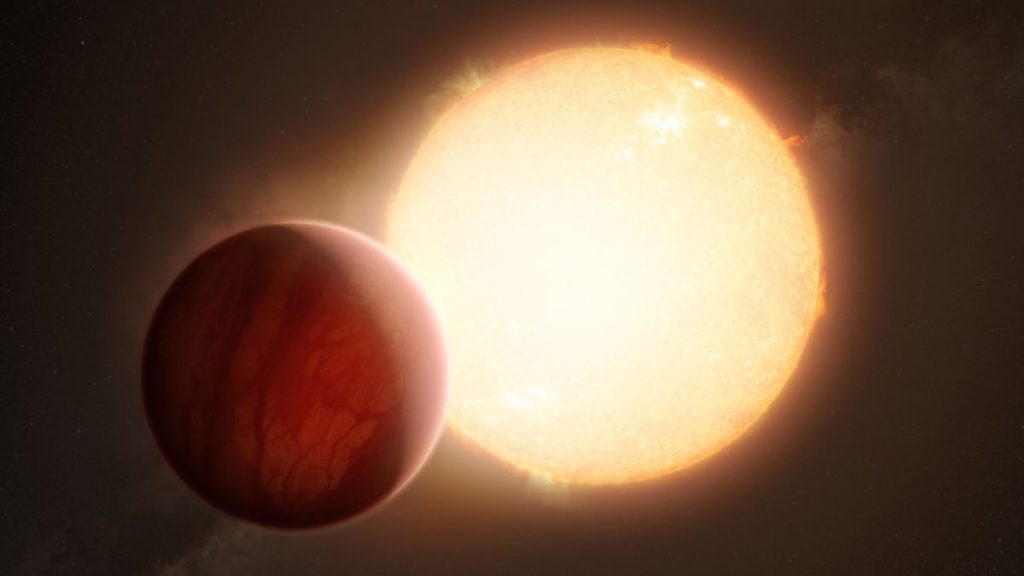Barium discovered on gas giants
Guess the element in the atmosphere of exoplanets
10/15/2022 5:27 PM
With two giant planets separated by hundreds of light years, researchers stumble upon something unexpected: they discovered the element barium in the upper atmosphere. But so far there is no reasonable explanation for how the heavy matter got there.
The two exoplanets WASP-76b and WASP-121b contain the heavy element barium in their upper atmosphere. This is evidenced by the high-resolution spectra obtained at ESO’s Very Large Telescope in Chile. It is the heaviest element so far discovered in the atmospheres of planets around other stars. And this presents a problem for astronomers: with the strong gravitational force of two planets, there should not be such heavy matter in the atmosphere, the discoverers wrote in the journal. “Astronomy and Astrophysics”.
This illustration shows the night side view of exoplanet WASP-76 b. On the day side (the transition between the two sides is shown on the left of the image) it gets hotter than 2,400 degrees Celsius. Even metals evaporate there. Strong winds carry iron vapor to the cooler night side, where it condenses and falls as iron rain.
(Photo: ESO/M. Kornmesser)
“Barium has to fall from the upper atmosphere very quickly,” explains Olivier Demangon of the University of Porto in Portugal. “At the moment, we have no idea what mechanism moves this element up.”
The two planets, which are 640 and 860 light-years away from Earth, are “hot exoplanets” – gaseous planets similar in size and mass to Jupiter in our solar system. However, they orbit their central star in a very narrow orbit with an orbital period of less than two days. Due to the proximity of the star, the atmospheric temperature is about 2000 ° C.
Such planets are particularly interesting objects for astronomers. “Because it’s mostly gaseous and very hot, it has extensive atmospheres, so we can observe and study the atmosphere much more easily than the atmospheres of smaller, colder planets,” Demangon says. The position of the planets’ orbits also helps sky researchers with these observations: they are oriented in such a way that the planets regularly pass in front of their central star when viewed from Earth.
During these “transits,” the planets block out part of the star, dimming its light – and these regular eclipses help in the discovery of the planets. Crucial to studies like Demangeon and colleagues, a tiny fraction of starlight shines through each planet’s atmosphere. In this portion of starlight, the atmosphere leaves a kind of fingerprint: the materials that make up the atmosphere absorb starlight at distinct wavelengths.
The first doubts about the discovery
The researchers can then use these “spectral lines” to determine what materials the planet’s atmosphere is made of. However, the whole process is time consuming and complicated. First of all, a high-resolution spectrometer is required, a special additional device on the telescope that splits radiation into wavelengths. Hence astronomers have to remove all the effects of the star as well as the Earth’s atmosphere from the data.
Demangeon and colleagues were initially able to confirm a large number of materials already indicated by previous observations. The researchers also discovered cobalt and strontium. Then they came across spectral lines of barium – and initially suspected that these actually come from exoplanets. “We didn’t look for barium, because we didn’t expect any barium there,” says Azevedo Silva of the University of Porto. Only after further examinations were the scientists convinced of their surprising discovery.
According to scientists, the discovery of barium in the atmospheres of two hot Jupiters indicates that these heavy elements can often occur in the atmospheres of extremely hot Jupiters. There must be previously unknown atmospheric currents carrying these materials into the upper atmosphere.

“Tv expert. Hardcore creator. Extreme music fan. Lifelong twitter geek. Certified travel enthusiast. Baconaholic. Pop culture nerd. Reader. Freelance student.”






More Stories
Roma and Sinti have to change places
Mysterious methane on Mars: NASA has a new theory
Mysterious methane on Mars: NASA has a new theory